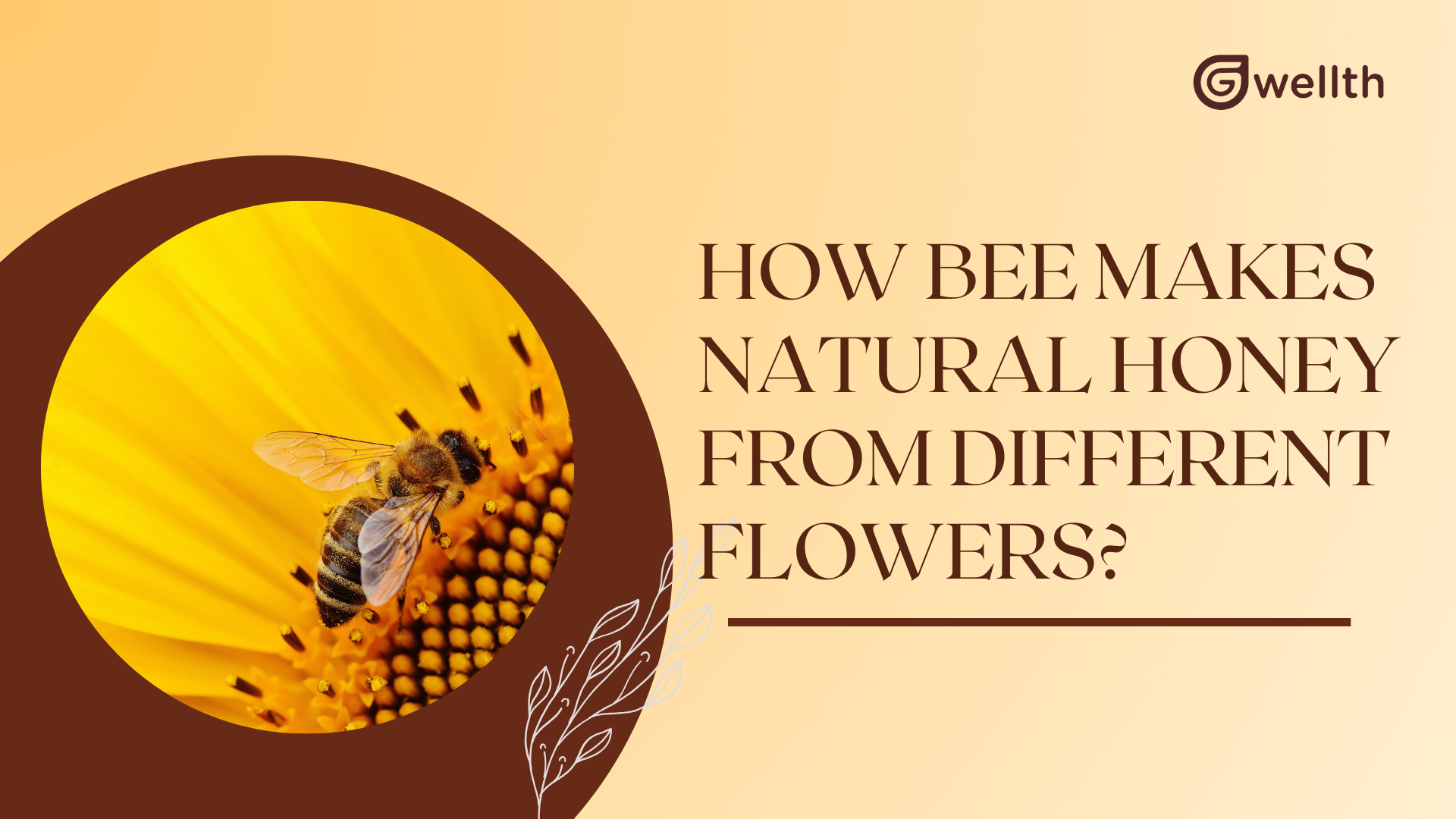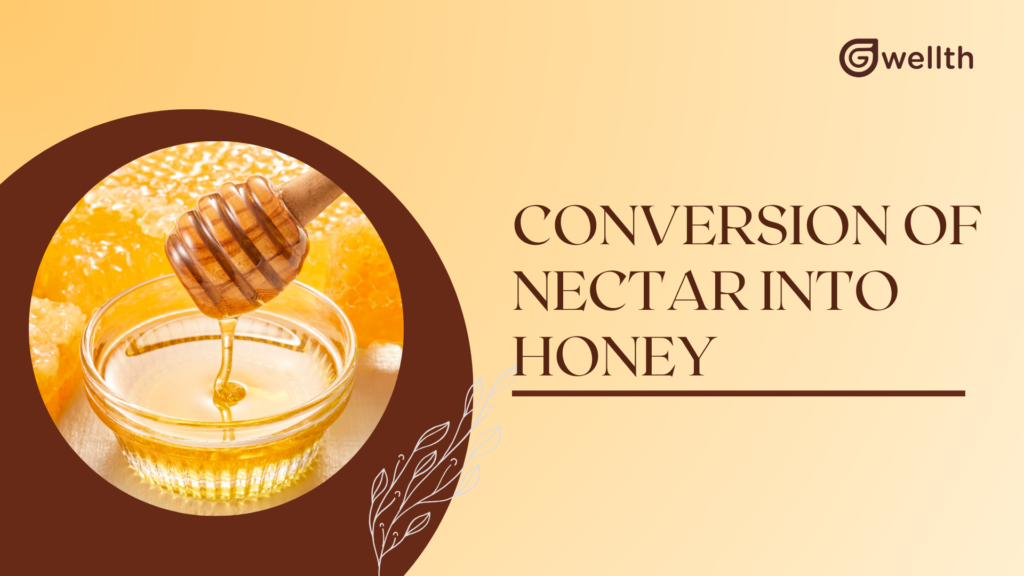Do You Know How Bee Makes Natural Honey From Different Flowers?

Bees turn nectar from various flowers into a delightful, golden confection known as honey, an intriguing natural product. Bees gather nectar, which is high in sugars, from flowers to start the process. Bees transform this nectar into honey by a special and complex process of digestion and evaporation, and they store the honey in their hives. The variety of flavors and qualities that natural honey can acquire based on the kinds of flowers that bees visit is what makes it even more unique.
This natural honey serves as both a delightful sweetener and a rich source of nutrients, rendering it an important component of a nutritious diet. In this blog, we will explore further the process by which bees collect nectar from a variety of flowers, leading to the creation of different honey types, each with unique flavors and health benefits.
What Is Honey?
Honey is produced by honeybees through the collection of nectar from flowers, which is then stored in a honeycomb. While this may appear straightforward, the process of honey production is a complex and challenging endeavor for the bees. In the honeycomb, honeybees collaborate as a cohesive unit. Their team comprises three distinct types of honeybees, namely the queen bee, the drone bee, and the worker bee, within a colony.
Honey has served as a cherished natural sweetener for centuries. Have you ever considered the fascinating process by which bees transform nectar from flowers into this golden substance? In this article, we will delve into the intricate methods employed by bees to produce honey, as well as how they gather nectar from a variety of blossoms to create diverse flavors and textures.
What Is Honey Made Of?
Honey is composed of various elements derived from flowers. Bees consume two primary types of food sourced from these plants: pollen, which serves as their protein source, and nectar, which provides carbohydrates. Nectar is a sweet liquid secreted by plants, predominantly containing sucrose. Within the honey stomach of the bees, enzymes convert this sucrose into simpler sugars, namely glucose and fructose. Additionally, honey encompasses vitamins, minerals, amino acids, enzymes, and floral compounds. The distinct flavors, aromas, and colors of different honey varieties are influenced by the specific plants from which the nectar is collected.
The Process Of Honey Production: A Detailed Overview.
As flowers begin to blossom, honeybees venture out from their hives in search of nectar-rich blooms. The honey-making process unfolds as follows:
- Upon locating a flower, bees utilize their elongated tongues to extract nectar, a sweet liquid, from the plant.
- This nectar is then stored in a specialized stomach referred to as the honey stomach.
- Once the bees have filled this stomach, they return to the hive and begin transferring the nectar to other worker bees through a process of regurgitation.
- These receiving bees will masticate the nectar for approximately 30 minutes.
- Subsequently, they pass it on to another bee.
- As the nectar is exchanged among the bees, it undergoes transformation into honey.
- Once the nectar has been converted, the honeybees deposit it into honeycomb cells, which function as waxen containers.
- To thicken the honey and achieve a syrup-like consistency, the bees fan their wings over it.
At this stage, experienced beekeepers can extract some of the finished honey from the hive, ensuring that the colony remains unharmed and intact.
Honeybees not only produce exquisite honey but also play a crucial role in pollinating flowers, thereby sustaining their growth. While observing the fascinating process of honey production is captivating, it is essential to remember that bees may sting if they perceive a threat.
The Essence Lies In The Flowers.
The primary factor influencing the color of honey is the variety of flowers from which the bee gathers nectar. The nectar from different plants contains unique minerals and compounds that alter the honey’s hue.
Are You Aware Of How Honeybess Locate Nectar?
They employ an extraordinary method to communicate with one another regarding the locations of fruitful flowers for nectar. This technique is known as the waggle dance. A returning or scout bee captures the attention of her fellow bees in the hive by climbing onto the back of another bee. She then begins to dance or waggle, using a specific movement code to inform others of the location of the nectar-rich flowers. The length of the waggle indicates the distance to the nectar source in relation to the sun. Moreover, the waggle dance also conveys the angle at which to travel away from the sun.
In summary, this is an impressive communication system that honey bees utilize to direct their companions in the quest for nectar.
Nectar Collection By Honeybees.
Worker bees are responsible for foraging to gather nectar. A worker bee has a lifespan of three to six weeks and plays a vital role in the entire honey-making process, as it is tasked with collecting nectar and pollen from flowers.
Each day, it travels approximately two to three miles from the hive, gathering nectar from thousands of blossoms.
The Conversion Of Nectar Into Honey.
Upon gathering nectar, honeybees return to the hive, where they transfer the nectar to fellow bees. Through a process of regurgitation, these bees introduce beneficial enzymes to the nectar. This remarkable process results in the transformation of floral nectar into honey.
The honey is subsequently stored in hexagonal structures known as honeycombs. Initially, honey contains a high moisture content; honeybees utilize the fanning of their wings to evaporate the excess moisture, thereby thickening the liquid. This stage is referred to as honey ripening. Afterward, the honeybees seal the comb to protect the matured honey using a substance secreted from their abdomen, known as beeswax.
The anatomy of a honeybee includes two stomachs: one designated as the ‘honey stomach’ for storing nectar before it is shared with other bees and the other as the ‘food stomach.’ This separation ensures that honey remains safe and hygienic.
GWELLTH: Start Your Journey Towards A Healthier Gut Today And Discover TheHealth Benefits Of Natural Honey.
Our brand, Gwellth, is one of the natural honey brands that offers prebiotic organic and natural honey. Adding prebiotic-rich food, such as prebiotic honey, into your diet is a simple habit with numerous health benefits.
CONCLUSION:
The method by which bees extract honey from various flowers is incredibly amazing and exemplifies the complex design of nature. Bees collect nectar from a variety of flowers to create a vast variety of natural honey with distinct tastes and health advantages. Probiotic-rich honey is unique among these types due to its gut-friendly qualities, providing a natural means of promoting digestive health. One well-known example is Jamun honey, which is made from the nectar of Jamun flowers and has several health advantages in addition to its rich, unique flavor. You’re not just indulging in a delight when you enjoy the sweetness of natural honey, the health benefits of probiotic-rich honey, or the distinct flavor of Jamun honey; you’re also supporting the amazing work of bees and the power of nature.
FAQs
Question 1. How do bees make honey from flowers?
Answer: Bees produce honey by extracting nectar from flowers with their elongated, specialized tongues. After gathering the nectar, they store it in a designated “honey stomach” and return to their hive. Within the hive, the bees regurgitate the nectar and share it with other bees, who then chew it to break down the complex sugars. This process decreases the water content of the nectar, transforming it into honey. The finished honey is subsequently stored in hexagonal wax cells, where it undergoes drying and maturation.
Question 2. Do bees exclusively use nectar from a single type of flower to create honey?
Answer: No, bees collect nectar from a diverse range of flowers, and this variety influences the flavor and color of the honey produced. Honey derived from the nectar of one specific flower type is referred to as “monofloral honey,” whereas honey sourced from multiple flower types is known as “polyfloral honey.”
Question 3. What accounts for the differing tastes of honey based on the flowers?
Answer: The taste, color, and texture of honey are shaped by the specific flowers visited by the bees. Each type of flower yields nectar with distinct levels of sugars, minerals, and flavors, which directly impact the taste and visual characteristics of the resulting honey.
Question 4. Are bees capable of producing honey from flowers that may not appear sweet?
Answer: Indeed, even flowers that do not seem sweet to humans can generate nectar that is abundant in sugars for bees. The bees are able to transform this nectar into honey, irrespective of its initial sweetness as perceived by humans.


